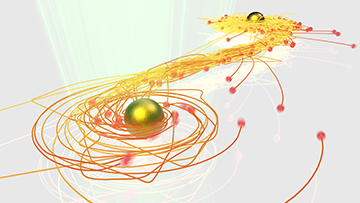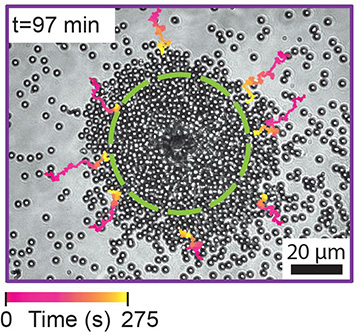
Researchers from Imperial College London and University College London, UK, have developed random lasers in which so-called Janus particles serve as hotspots for self-organized laser activity—and in which lasing can even be controllably swapped from one hotspot to another. [Image: Wai Kit Ng/Imperial College London]
While we tend to think of lasers in their “classical” form—consisting of a resonant cavity and a crystalline gain medium—other configurations are possible, too. One laser family that has spawned considerable recent work is so-called random lasers, in which repeated scattering of light off of a disordered collection of particles, rather than a pair of fixed mirrors, facilitates the task of optical confinement and amplification. But even random lasers, once set up, tend to be static and fixed in the actual functionalities they offer.
Researchers at University College London (UCL) and Imperial College London (ICL), UK, have now taken an intriguing step toward reconfigurable, programmable random lasers (Nat. Phys., doi: 10.1038/s41567-022-01656-2). In the team’s setup, dissipated colloidal suspensions of microparticles in a liquid gain medium can be triggered to self-organize into random lasers. The researchers found that multiple such lasers could even be tweaked to “cooperate,” with one microscopic colloidal hotspot swapping lasing activity with an immediately adjacent one in a predictable way.
The team believes the work will help enable the creation of laser systems and photonic materials that can mimic some properties of living systems, such as adaptation, self-healing and collective behavior. Doing so, the authors write, could engender “a new class of functional materials with potential for sensing applications, nonconventional computing, novel light sources, speckle-free illumination and display technology.”
Bio-inspiration
In a colloidal random laser, microparticles suspended in a laser dye, if brought close enough together, can be used to amplify light pumped in from outside. Specifically, if the local density of microparticles rises above a specific threshold, pump light bouncing off of the suspended particles remains confined long enough for net gain to occur before the light exits the dense area—resulting in a laser emission. But while colloids provide an intriguing and potentially flexible design palette, developing and fabricating random lasers with controllable outputs can take considerable work.
The team behind the new work—led by ICL physicist Riccardo Sapienza and UCL chemist Giorgio Volpe—wanted to find a way to make random lasers more programmable and adaptable. To do so, the researchers took a cue from living systems, which are capable of self-assembling and reconfiguring on the fly as conditions change. “We asked ourselves,” Sapienza said in a press release accompanying the research, “if we could create a laser with the ability to blend structure and functionality, to reconfigure itself and cooperate like biological materials do.”
Janus particle attraction
Microparticles clustering around a Janus particle. The dashed line delineates the lasing area, and the pink/yellow lines show the tracks of several microparticles. [Image: Imperial College London] [Enlarge image]
To get there, the team needed a mechanism for reversibly attracting colloidally suspended microparticles to a central point. The researchers settled on so-called Janus particles to do this work. Janus particles are spherical microparticles that have two distinct faces with different physical or chemical characteristics. The team reasoned that a properly designed Janus particle, when pumped with laser light, could serve as a sort of microheater that would draw other microparticles into its area, allowing their spontaneous organization into a random laser.
The ICL–UCL team used suspension chemistry to fashion Janus particles in the form of 4.22-µm-radius silica microspheres, coated on one side with a 60-nm-thick layer of carbon. The researchers then dumped the Janus particles into an ethanol solution that contained suspended, smaller microparticles of titanium dioxide (TiO2), and that was also spiked with a rhodamine-based laser dye to serve as a gain medium.
When the researchers illuminated the Janus particles with a continuous-wave, 633-nm laser, they found, as expected, that the Janus particles absorbed the incident light and heated up. In response to that local heating, the thermophilic suspended TiO2 microparticles swarmed in toward the Janus particle hotspot.
Then, the researchers pumped the hotspot area with a second, pulsed 532-nm laser, and monitored the emission spectrum from the area as the concentration of TiO2 microparticles increased around the Janus particle. When the density of the microparticles reached a critical threshold, the emission linewidth from the system narrowed to half of its initial value—a clear sign that random lasing was taking place. And when the continuous-wave spot illuminating the Janus particle was turned off, the Janus particle quickly cooled, the TiO2 particles dissipated away and the random lasing ceased.
Cooperation among lasers

Clusters of lasing microparticles form different patterns around groups of Janus particles. [Image: Imperial College London]
The team also found that multiple self-organized colloidal lasers could engage in “collaboration.” When two Janus particles were separated by roughly the distance of a pump spot, and the particles alternately heated, the colloidal particles could be made to accumulate and lase separately, with the lasing activity effectively and controllably swapped between one zone and the other.
Putting more than two Janus particles together allowed the laser properties to be boosted and made increasingly effective. It also enabled the spontaneous emergence of different planar geometries—for example, triangular or hourglass-shaped arrays—that the team thinks could be important in some applications.
Toward a new class of materials?
One disadvantage of the system demonstrated by the ICL–UCL team is that it’s on the slow side; reconfiguring of the random lasers takes minutes in this system. But the researchers stress that faster speeds should be achievable in the future via systems that use optical or electrical fields instead of or in addition to thermal stimuli. Such systems could, the team believes, eventually become useful in applications such as “electronic ink” for smart displays.
More broadly, the researchers view the new work as “a first step towards the realization of fully animate lasers capable of independent motion and autonomous adaptation in response to external stimuli.” And they believe the effort could lead to “a new class of active functional materials” for sensing, computing, light sources and other applications.

